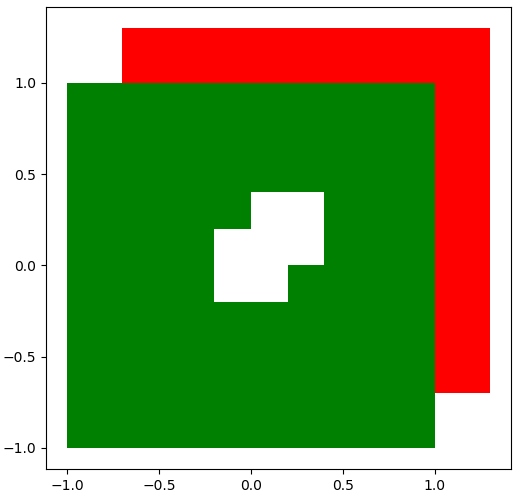Hello Matplotlib Developers!
- Matplotlib has a Clipping capability, but the “clipped” out areas use the same zorder,
therefore rendering several overlapping polygonal shapes visible based on their zorder
does not work in the areas where clipping was used to render one of them.
- If it were possible to “reset” the zorder of a given pixel color (our background color) at any time while rendering, then we would have resolved
the issue with clipping. We would not even need clipping as we could just use a given zorder value for the parts that define our desired mask areas,
and a lower zorder for the part to be clipped, and after rendering the part in question, we change the zorder of all the “white” pixels to a low
zorder value, and we have the masking capability working !
If this is not possible with the current version of Matplotlib, please can you help me giving me the code needed ?
Example for illustration (see attached snapshot figure):
‘’'Example of two overlapping squares having arbitrary openings in them.
In this example the opening is just two smaller overlapping square, but it can be anything.
We want to paint the green and red squares so that we see what is behind the opening(s)’’’
import matplotlib.pyplot as plt
fig, ax = plt.subplots(figsize=(6, 6))
This is to test if a well ordered polygon with slits (to define holes) can be rendered
quad_small = [(-0.2, -0.2), (-0.2, 0.2), (0.2, 0.2), (0.2, -0.2), (-0.2, -0.2)]
quad1x1 = [(-1, 1.), (-1, -1.), (1, -1.), (1., 1.), (-1, 1.)]
#Fill quad1x1 with green
x11 = [coord[0] for coord in quad1x1]
y11 = [coord[1] for coord in quad1x1]
plt.fill(x11, y11, facecolor=‘green’, zorder=5)
‘’'Now make one or more holes, possibly overlapping holes,
NOTE: if we use clipping to define the holes, Matplotlib sets the same zorder over all the clippped areas
which was used. Also clipping does not work well with overlapping small squares. Would only work with nonoverlapping
squares.’’’
xsq = [coord[0] for coord in quad_small]
ysq = [coord[1] for coord in quad_small]
plt.fill(xsq, ysq, facecolor=‘white’, zorder=5)
xsq = [coord[0]+0.2 for coord in quad_small]
ysq = [coord[1]+0.2 for coord in quad_small]
plt.fill(xsq, ysq, facecolor=‘white’, zorder=5)
‘’'At this point green and white openings have the same zorder=5.
We would need a call to change the zorder of all the ‘white’ pixels to a lower value, say 3’’’
‘’'Now we want to render another polygon (red) with holes, but ONLY on areas not covered by the previous rendering,
we use a lower zorder so that we do not paint on the green part’’’
x11 = [coord[0]+0.3 for coord in quad1x1]
y11 = [coord[1]+0.3 for coord in quad1x1]
plt.fill(x11, y11, facecolor=‘red’, zorder=4)
xsq = [coord[0]+0.3 for coord in quad_small]
ysq = [coord[1]+0.3 for coord in quad_small]
plt.fill(xsq, ysq, facecolor=‘white’, zorder=4)
xsq = [coord[0]+0.5 for coord in quad_small]
ysq = [coord[1]+0.5 for coord in quad_small]
plt.fill(xsq, ysq, facecolor=‘white’, zorder=4)
‘’‘The hole (white area) of the green square is not painted in red because the zorder of the white area is higher’’’
plt.show()

···
Schlumberger-Private